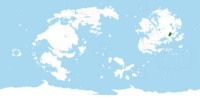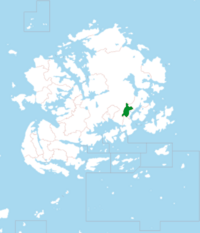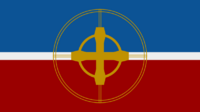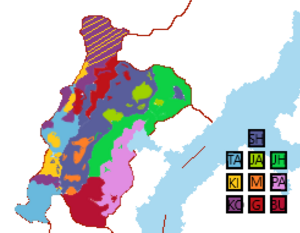Mahana
Federal Democratic Republic of Mahana संघीय लोकतान्त्रिक गणतन्त्र महान Saṅghīya lōkatāntrika gaṇatantra Mahāna (Mahanan) | |
|---|---|
Coat of arms
| |
Motto: "Adbhuta pahāḍī rājya" "Bound by Democracy" | |
Anthem: Shreeman Gambhir | |
  | |
| Largest city | Jutpandi |
| Official languages | Mahanan |
| Recognised regional languages | Mahanan Sanpujri Gurung |
| Ethnic groups (2012)National Census | 16.6% Sheshtri 12.2% Gaimreti 7.1% Mai 6.6% Tamang 5.8% Jhimpe 5% Jamuni 4.4% Butwali 4% Koshi 2.3% Kiralimbu 2% Pashimari 1.5% Shivalaya 21.93% Other Ethnic Groups |
| Religion | 81.3% Gaism 9.0% Buddhism 4.4% Hinduism 3.1% Kirant 1.4% Islam 0.5% Christianity 0.5% Prakriti 0.3% Others |
| Government | |
• Prime-Minister | Ranju Bastola |
• President | Bina Sharma |
• Queen | Sharma II |
| Legislature | Federal Parliament |
| National Assembly | |
| House of Representatives | |
| Population | |
• 2021 estimate | 27,450,000 |
• 2012 census | 27,437,492 |
| Currency | Mahanan Rupee |
| Time zone | UTC+8 |
| Driving side | left |
| Calling code | +989 |
This article is incomplete because it is pending further input from participants, or it is a work-in-progress by one author. Please comment on this article's talk page to share your input, comments and questions. Note: To contribute to this article, you may need to seek help from the author(s) of this page. |
Mahana (Mahanan: महान or Mahāna|Pronounced in English: Mah-han-ah), officially the Federal Democratic Republic of Mahana is a country in Europa, more specifically the sub-continent of Orient, which consists of 27 million people. The capital city is Jutpandi but other large cities include Ghobari, Battagara and Veydu. The most notable feature of Mahana is the Samripe Mountain Range, one of the largest on Eurth, and specifically Mount Monjara, standing at 7,963m tall. The most followed religion in Gaism, a religion centred around the worship of the bovine God of Kuladara. Mahana is made up of a huge amount of differing ethnic peoples, including the Sheshtri, Gaimreti and the Mais. The name 'Mahana' literally translates to 'Great' in the native language.
Etymology
The term 'Mahana' first appeared upon initial unification in the 13th century, during the Sapkota Dynasty. In Old Mahanan (पुरानो महन्त लिपि) the word is thought to originally have meant 'Land of the Great Kings'. In modern Mahanan the word Mahana simply means 'Great'.
Geography
The most notable feature of Mahana is the Samripe Mountain Range, one of the largest on Eurth, and specifically Mount Monjara, standing at 7,963m tall.
(WIP. The majority of the nation's population live behind the Samripe Mountain range. This includes all the major ethnic groups. The 'lowland' ethnic groups would be the first ones to have interaction with other countries, as they are located by the sea. I haven't figured out when the lowland peoples arrived or where they came from yet, but I do know that they are ethnically quite different from the mountainous groups.)
Biodiversity
Mahana is hugely biodiverse nation, with the country often put into three sub-categories; the 'Plateau', which is the Careleon Plateau, the 'Highlands', which is the Samripe Mountain Range and the 'Lowlands' which make up the south-western part of the nation.
History
Ancient Mahana
- Prehistory — (WIP. Inspiration can be found in this reference of Meluhha. This could also be the coastal area southeast of you. Several nearby places all begin with the letter "M": Miiros, Mekabiri, Mahana, Mantella.)
- 100s BCE — (WIP. Integration with the Pearl Road trade network.)
- (WIP. Figure out a shared heritage with the neighbouring countries.)
Medieval Mahana
- 1000s — Mahana was established officially in the 11th century as Emperor Chamrel lead the ancient Khad peoples down the Ghobari valley and into the area of modern day Jutpandi. These early peoples were believed to have been the first to practise Gaism in the region, as well as founding the ancient city of Vaddkewatta, which is situated in modern Jutpandi.
- 1100s — These people were led by the Chamrel Dynasty until the late 12th century, when they were deposed following the Mahanan Civil War, putting the Sapkota Dynasty into power.
- 1200s — It was in the 13th century when they doubled the amount of land they occupied, roughly to the modern borders, under the Sapkota Dynasty and notably Emperor Guragai.
- 1280s — It was in the very late 13th century in which Emperor Rabi introduced the caste system to Mahana. Mahana's downfall was upon the death of Emperor Jhapali, his three sons disagreed on land inheritance, resulting in the land being split into three.
- 1350s — (WIP. Expect some coastal raids during the Orinese colonial period. This would work well with the downfall you described above. A period of internal instability would help explain an external threat.)
Mahanan Unification
- 1700s — Mahana remained in this way until it was united in the 18th century by a man named Balraj Singh who lead one of the three ununified states, Jalanpathur.
- 1875-1900 — The current borders of the nation were drawn up in the late 1800s, and have remained stable since.
Contemporary Mahana
- 1900s — In the early 1900s, a man named Sudip Subba managed to successfully take power, forcing the monarch to become a secondary power and announcing himself as supreme leader or Subban. Afterward, the kings of Mahana were only figureheads and the Subban held the real power.
- 1943 — However, in the year 1943, the Gayin (Head of the Gaism religion) stated that the Subban was not the rightful leader of Mahana at any given time, restoring power back to the king, with the Subban position fading following this.
- 1992 — an uprising and widespread protests lead to the country establishing a parliament and having a 'stable' democracy.
- 2021 — Today, Mahana remains a poor country, with most working in farming. However, Mahana is seen to have great tourist potential, with 26 million visitors in 2020. They are exporters of materials such as plastics and soft metals, as well as tea and other goods.
Politics
Mahana is a Federal Democratic Republic.
- Monarch: Queen Sharma II
- President: Bina Sharma
- Prime-Minister: Ranju Bastola
Legislature: Federal Parliament (bicameral
- Upper house: National Assembly
- Lower house: House of Representatives
Economy
Today Mahana remains a poor country, with most working in farming. However, Mahana is seen to have great tourist potential with 26 million visitors in 2020. They are exporters of materials such as plastics and soft metals as well as tea and other goods.
(WIP. Currency: Mahanan Rupee.)
Culture
(WIP. Based heavily on Nepali and Northern Indian culture.[1])
Cuisine
Ethnic Groups
There are 27 million people in Mahana, including a huge amount of differing ethnic peoples, including the Sheshtri, Gaimreti and the Mais.
Religion
The most followed religion in Gaism, a religion centred around the worship of the bovine God of Kuladara.
Arts
References
- ↑ Vision statement of Mahana (11 December 2021)










